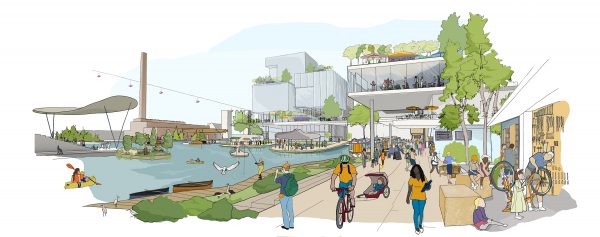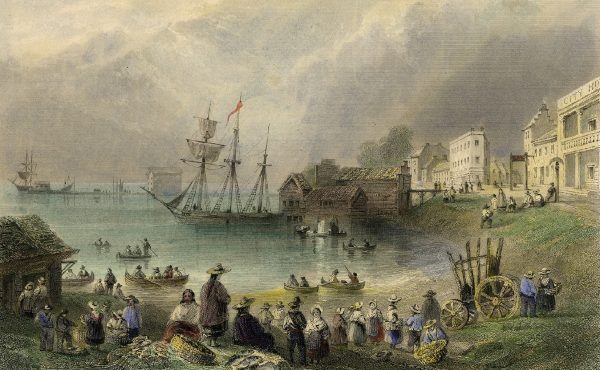Waterfront Toronto’s public positioning to accompany the gang-plank resignation yesterday of its now former CEO Will Fleissig could be summarized thusly: “Nothing to look at here, please keep moving.”
Of course, nothing could be further from the truth. Let’s take a short stroll through the evidence:
- The long-promised completion of the master innovation and development plan for the Sidewalk Labs’ pitch for Quayside has been pushed back yet again, with the agency and its New York-based partner signalling in recent weeks that it won’t be released now until early 2019.
- Despite repeated promises of transparency and pious public assurances of disclosure going back to the beginning of this year, Waterfront Toronto officials still haven’t made public the secretive framework agreement that lays out its relationship with Sidewalk Labs, a subsidiary of Alphabet/Google.
- The agency has seen a fair amount of internal turn-over, and earlier this spring hired a top communications/public relations manager from Hill+Knowlton Strategies, a move that, on its face, indicates that Waterfront Toronto knew it had to do something to contain the dumpster fire of negative media coverage generated by all the uncertainty swirling around the Sidewalk scheme.
- Meantime, Sidewalk Labs, the counterparty, hired John Brodhead, an incredibly well connected Liberal insider, to help with…well, everything. Except having taken that seemingly prudent step at soothing the nerves of Waterfront Toronto’s government partners, the company has continued to insist on running this project out of New York.
While many people have laid claim to asking Dan Doctoroff’s tech-based city-building start-up to consider establishing a beachhead in Toronto, I have no qualms about laying a large portion of the blame for the ensuing mess at Fleissig’s feet.
From the moment Waterfront Toronto announced that Sidewalk Labs had won the spring 2017 request for proposals competition for Quayside, Fleissig insisted, unaccountably, on blurring the lines between a government agency mandated to protect the public interest and the private interests of a voracious corporation bidding on a very lucrative project.
Those lines are not just important; they are foundational. And yet, Torontonians watched as a civil servant and his staff repeatedly referred to Sidewalk Labs as a “partner” and the plan for Quayside as a “joint venture,” as if public and board approval of whatever Sidewalk Labs conjured up were merely procedural formalities. They aren’t, and Fleissig simply shouldn’t have allowed himself to become so star-struck by a heavy-hitter like Doctoroff to lose sight of this basic fact.
The rhetorical murkiness pre-dates Sidewalk Labs’ formal unveiling, of course: the Quayside RFP, Fleissig’s brainchild, was a masterwork of slick ambiguity — ostensibly a request for bids on a small sliver of waterfront land, but actually a document filled with winks and nudges about the much more expansive commercial opportunity that awaited on the Portlands (a.k.a., the “eastern waterfront”). Sidewalk Labs and its deep-pocketed backers picked up on those signals loud and clear.
It’s important to note that for the entirety of Waterfront Toronto’s existence, the agency had taken a methodical, precinct-by-precinct approach to re-developing the waterfront. The success of this notably unambiguous strategy, developed by former CEO John Campbell, is manifest: the waterfront is attracting capital, people, and employers. Go look if you doubt me. There are cranes all over the place. Was this a problem in search of a solution? Nope.
And yet…
Conjuring a re-development fantasy populated by tech-savvy builders, platform-savvy urbanists, and that sub-species of 21st century entrepreneur who worships at the alter of continuous disruption, Fleissig abandoned all that past success, and pressed ahead instead with a tone deaf strategy.
In the name of speed and innovation, he blew off the agency’s meticulously cultivated relationships with the members of the public who have been thoroughly engaged with Waterfront Toronto’s work for almost a generation. But having forced this cultural shift, Fleissig failed to create within Waterfront Toronto sufficient professional capacity to properly assess and value whatever it is that Sidewalk Labs is promising to build or test here. Indeed, it was blindingly obvious from the get-go that Waterfront Toronto was in way over its head with Sidewalk Labs, and still is, in fact.
So, almost a year into this process, no one has satisfactorily answered the most fundamental question hovering over this debacle: if Waterfront Toronto’s redevelopment process wasn’t broken — and it wasn’t — why did Fleissig take it upon himself to fix it? And why did the board let him change course so dramatically?
As of today, the veteran pension executive and Waterfront Toronto board member Michael Nobrega is temporarily at the helm as the board embarks on a search to replace Fleissig. No doubt, Waterfront Toronto’s directors will be looking for someone with development chops, financial savvy and, I’d hope, a far better ear for the politics than Fleissig demonstrated. In short, someone who knows, as the saying goes, the waterfront.
But if I were on that search committee, I’d also be asking candidates this key question: if you got the job, would you advise that we, as an agency, continue with Sidewalk Labs or rather hit re-set and resume a proven, made-in-Toronto development formula?
The person willing to respond honestly will be the one to hire.
rendering courtesy Sidewalk Labs






5 comments
Once again, Lorinc reports what others fail to.
Will Fleissig may not have handled this well, but Sidewalk may represent an opportunity for Toronto to become a showcase smart city – in a world that will in a few decades see 70% of humanity living in cities, up from today’s 50%.
Let’s face it, Toronto has been anything but visionary in its urban planning. If this results in Sidewalk’s withdrawal, don’t expect anything more than the usual haphazard patchwork of greedy land grabs. That’s it for now – off to Sugar Beach for the holidays
Key points: “if Waterfront Toronto’s redevelopment process wasn’t broken — and it wasn’t” and “In the name of speed and innovation, he blew off the agency’s meticulously cultivated relationships with the members of the public who have been thoroughly engaged with Waterfront Toronto’s work for almost a generation”
It is broken . This shouldn’t take a generation to make progress. The incumbents can’t get this done. They had a generation to develop a huge asset and failed to do.
Richard says: ” This shouldn’t take a generation to make progress. The incumbents can’t get this done. They had a generation to develop a huge asset and failed to do.”
I don’t know what on earth Richard is looking at but the waterfront has been developing quite fast over the last 15 years. Despite the recent blip after Campbell left, Waterfront TO has been a model for the city to use on how to engage the developers, residents, and city hall and produce quality public spaces and buildings.
Did someone say monorails and ferris wheels?
https://www.thestar.com/news/gta/2011/08/30/doug_fords_dream_waterfront_ferris_wheel_monorail_and_a_boatin_hotel.html
“Doug Ford’s dream waterfront? Ferris wheel, monorail and a boat-in hotel
By DAVID RIDER AND DANIEL DALEUrban Affairs Bureau
Tues., Aug. 30, 2011
Councillor Doug Ford has laid out his most detailed vision for Toronto’s eastern waterfront, with a monorail skimming along the shore, a 1.6-million-square-foot “megamall” and island airport users boating right into their hotel lobby.
Ford, the brother and closest adviser of Mayor Rob Ford, laid out his vision in an interview Tuesday morning on CBC Radio’s Metro Morning.
The interview came on the heels of the Ford administration revealing it wants to seize control of port lands redevelopment from Waterfront Toronto, a tripartite agency to which Ottawa, Queen’s Park and the city have each contributed $500 million….”